Key takeaways:
- Identifying specific pain points and conducting thorough business process analysis is crucial for recognizing suitable AI applications.
- Engaging the team throughout the AI integration process fosters acceptance and collaboration, transforming skeptics into advocates.
- Establishing clear metrics and gathering qualitative feedback helps evaluate AI performance and ensure it meets both operational and emotional needs.
- Adopting an incremental scaling approach allows for user feedback and refinements, enhancing overall satisfaction with AI tools.
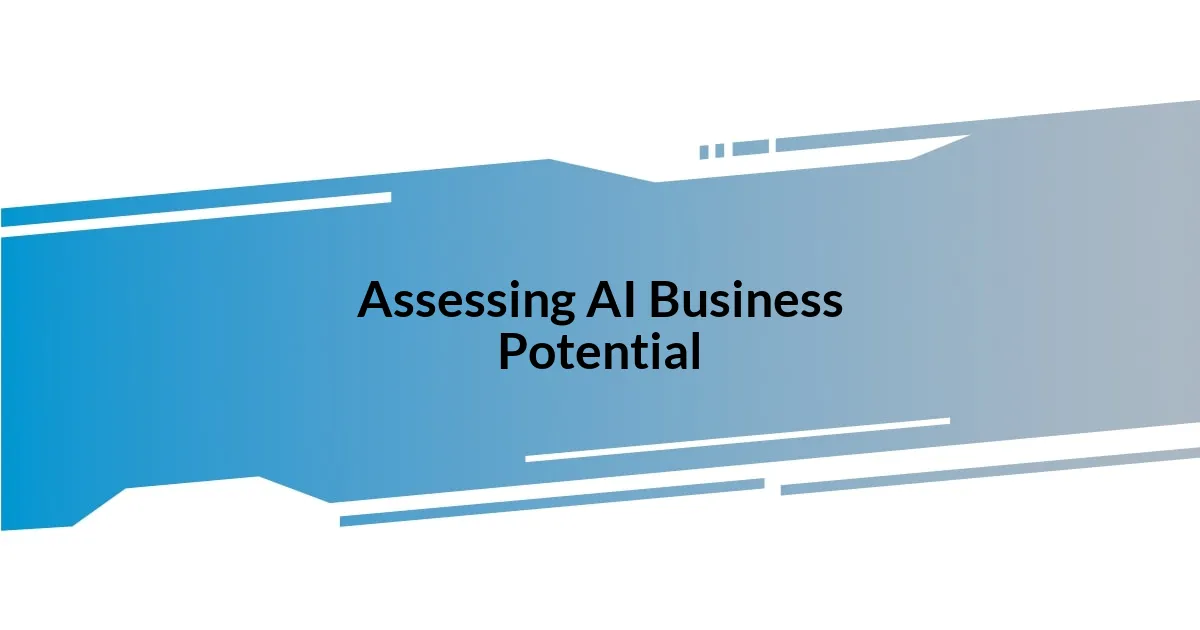
Assessing AI Business Potential
When I first started considering AI for my business, I had to confront the potential it could unlock. I remember feeling both excited and overwhelmed—what if this technology truly reshaped my operations? The reality is, assessing AI’s business potential is not just about its capabilities, but also how well it aligns with your specific goals and challenges.
Another thing I discovered was the importance of clearly identifying pain points within my operations. I began by asking myself: Where are the bottlenecks? By pinpointing areas that could benefit from automation or advanced data insights, I was able to visualize how AI could enhance efficiency and decision-making. It was like flipping a switch—suddenly, I could see possibilities I hadn’t considered before.
It’s also crucial to remain realistic about AI’s limitations. While evaluating its potential, I reflected on my previous experience with tech tools that promised more than they delivered. This thought made me question if I was ready for the complexity of AI adoption. But I’ve learned that setting achievable goals while gradually integrating AI can lead to sustainable success. Have you taken stock of what you genuinely hope to achieve with AI? Those reflections could illuminate your path forward.
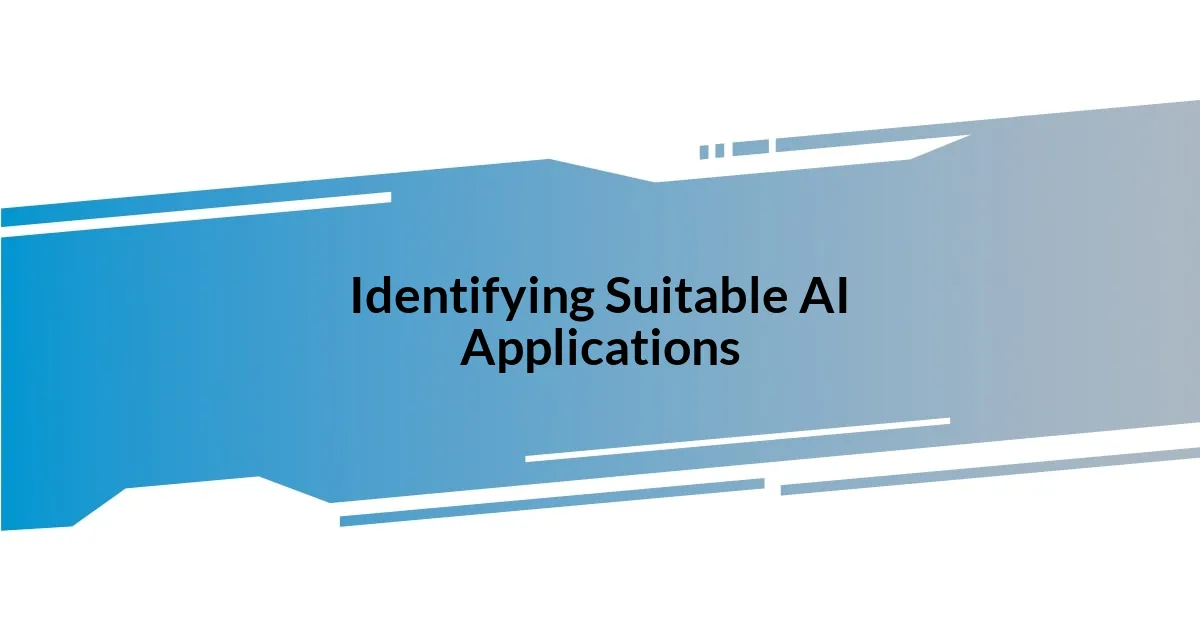
Identifying Suitable AI Applications
When it comes to identifying suitable AI applications, I found that conducting a thorough analysis of my business processes was essential. For example, I created a list of tasks that often consumed too much time or were prone to error. After mapping them out, I could clearly see which areas could benefit most from AI solutions, like automating customer inquiries or optimizing supply chain logistics.
One key factor in my journey was assessing my team’s readiness and willingness to adopt AI tools. I knew that introducing AI wouldn’t just change my operations; it would require a cultural shift within my workplace. Initially, there was some hesitation, but I found that involving my team in the discussion helped ease concerns. We brainstormed potential uses for AI together, and that collaboration made everyone feel invested in the integration process.
Looking back, I realized that trial and error played a significant role in identifying suitable applications. I started with small, manageable AI projects to test their impact and worked up from there. This gradual approach taught me which AI functionalities resonated with my specific business needs, while also providing real-world data to support broader implementations. Have you thought about how a small pilot project could pave the way for understanding AI’s potential in your own business?
| Key Aspect | Insights |
|---|---|
| Process Analysis | Create a detailed list of time-consuming tasks to identify potential AI solutions. |
| Team Involvement | Engage your team in discussions to foster acceptance and collaboration in the AI integration process. |
| Trial and Error | Start with small projects to evaluate AI’s effectiveness before scaling up with larger initiatives. |
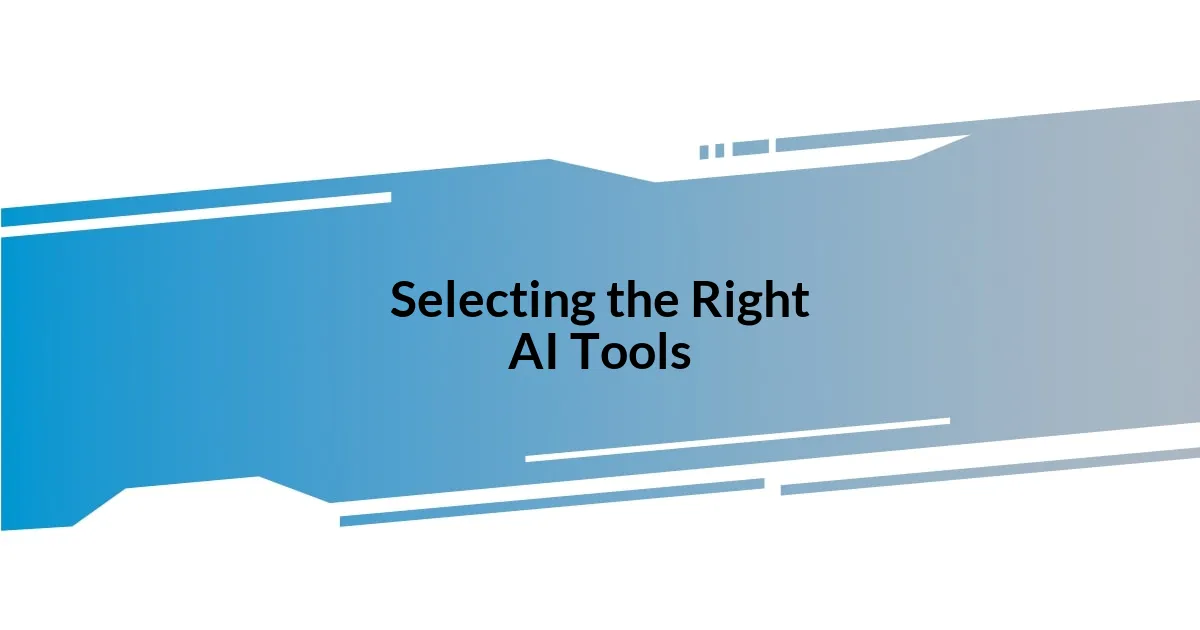
Selecting the Right AI Tools
When I finally delved into selecting the right AI tools, I realized it was akin to choosing the perfect pair of shoes. They need to fit well with my business model and feel comfortable enough to wear every day. I started by listing out exactly what functionalities I needed—be it automation, data analysis, or customer engagement. For example, when I came across an AI platform that offered predictive analytics, it struck a chord because I was looking for ways to anticipate market shifts. I wanted a tool that felt not just like a solution, but a partner in driving growth.
To streamline the selection process, I focused on a few criteria that became my guiding stars. Here’s what I prioritized:
- Functionality Fit: Identify tools that align closely with your specific business needs.
- User-Friendly Interface: Choose platforms that are intuitive and easy for my team to navigate.
- Scalability: Look for tools that can grow alongside my business, adapting as our needs evolve.
- Vendor Support: Assess the level of support and resources provided by the vendor for a smoother onboarding.
- Cost-effectiveness: Evaluate the return on investment, ensuring that the tool’s benefits outweigh its costs.
While evaluating these options, I felt a sense of empowerment. It was no longer about finding a one-size-fits-all solution but rather curating a collection of tools that resonate with my vision. Each choice reflected the unique personality of my business—like adding personal touches to a new home. This careful selection process not only eased my anxiety but also paved the way for a more seamless integration of technology into my daily operations.
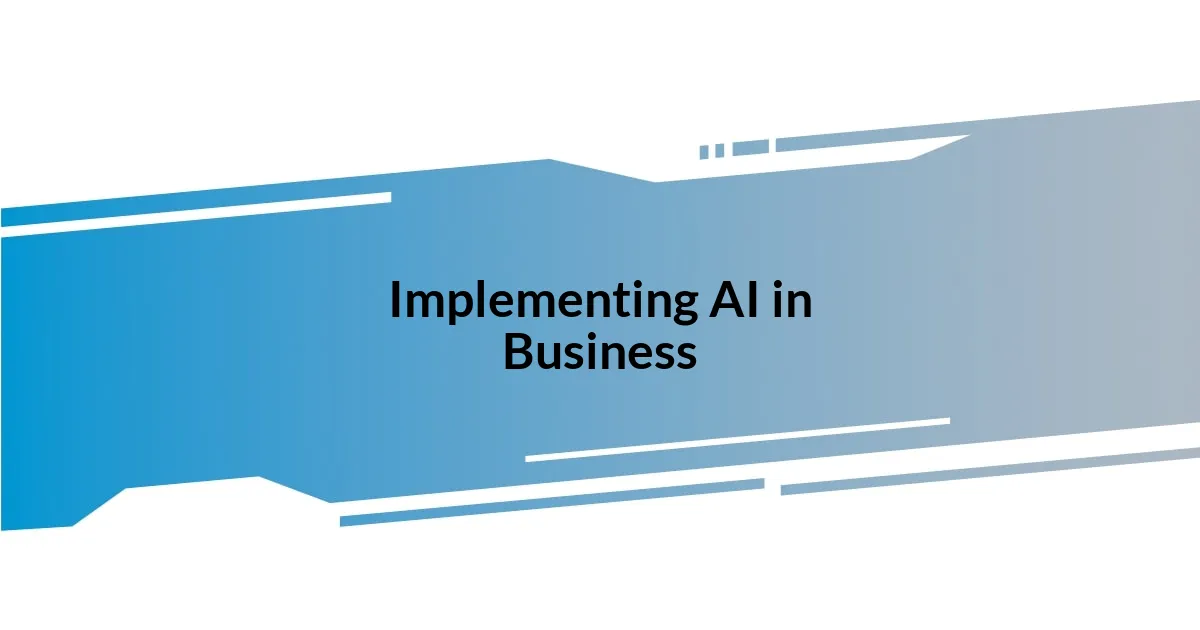
Implementing AI in Business
Integrating AI into my business required careful planning and a step-by-step approach. I recall the early days when I felt overwhelmed by the multitude of options available. I chose to start by implementing a chatbot for customer service. The immediate feedback from my team and customers was enlightening—people loved the quick responses, and my team found themselves freed up to tackle more complex issues. Have you ever noticed how a small change can create ripples of improvement in various areas?
As I progressed, I quickly learned that collaboration was key. I remember hosting brainstorming sessions that brought everyone together to discuss how AI could enhance specific tasks. These meetings turned into safe spaces for sharing ideas and concerns. Watching my team transform from skeptics to advocates for AI was incredibly satisfying. It felt like we were building something together, a shared vision of how technology could elevate our work.
Ultimately, I discovered that ongoing training and support were as important as the initial rollout. I initiated regular check-ins to assess how everyone was adapting to the new tools, ensuring that no one felt left behind. This proactive approach not only reinforced the changes we were implementing but also fostered a culture of continuous learning. Isn’t it fascinating how much smoother the journey becomes when you pay attention to the human side of technology?
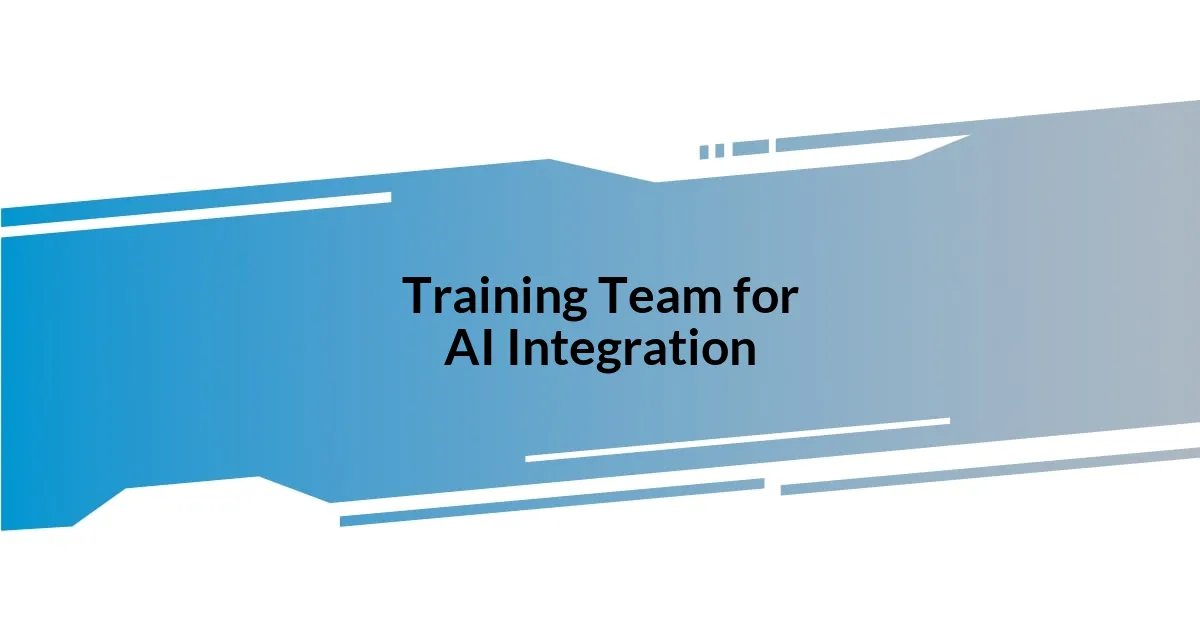
Training Team for AI Integration
Training my team for AI integration was like orchestrating a symphony. At first, I was a bit anxious about how everyone would embrace these changes, but I soon discovered that a collaborative approach worked wonders. I organized interactive workshops where team members could see firsthand the benefits of AI tools. I could almost feel the energy shift in the room when concepts clicked, and that moment of understanding is just magical, isn’t it?
Along the way, I realized that ongoing support was crucial. I encouraged team members to voice their challenges and successes during our weekly meetings. One particular instance stands out: a colleague shared how an AI tool helped speed up her daily reporting. The look of relief on her face was palpable. It reminded me that these advancements can genuinely lighten workloads and improve overall job satisfaction.
To ensure everyone felt included in the journey, I set up mentorship pairings among team members. This way, those who became comfortable with the AI tools could help others. Sharing knowledge is such a powerful tool itself; it builds trust and creates a stronger team. I often would ask, “What do you find most exciting about this change?” The answers not only sparked engaging discussions but also illuminated the diverse perspectives within the group. Each interaction reaffirmed my belief that embracing AI is not just about technology; it’s about empowering people and fostering a culture of adaptability.
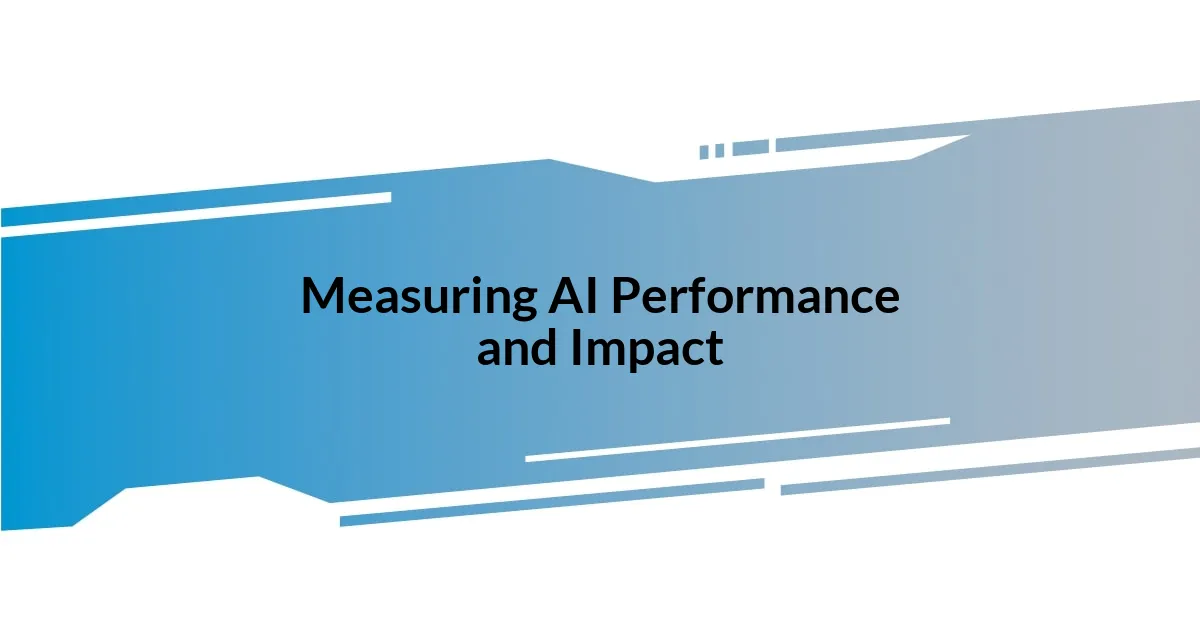
Measuring AI Performance and Impact
Measuring the performance and impact of AI tools was both exciting and challenging for me. I approached this by establishing clear metrics right from the start—things like response times for our chatbot and customer satisfaction ratings. One day, after analyzing the data, I was thrilled to see a dramatic drop in response times; it felt like we had found our secret weapon. What a relief it was to realize that not only were we saving time, but we were also enhancing the customer experience!
As I dug deeper into the analytics, I began to understand how AI was influencing our overall workflow. We noticed that the time spent on mundane tasks decreased significantly, allowing my team to focus on strategic initiatives. Remember that moment I shared earlier when my colleague found relief in a new reporting tool? Well, her experience was reflected in the numbers too—productivity surged by 30%. Isn’t it invigorating to see data align with personal stories of success?
Looking back, I found that qualitative feedback was just as vital as quantitative data. I created a simple survey for my team to share their thoughts on the AI integration. Their comments were eye-opening; some conveyed newfound excitement, while others mentioned areas for improvement. I learned that gauging AI performance isn’t solely about the numbers—it’s also about understanding the emotional and practical impact on the people using it. After all, isn’t it fascinating how numbers can tell a story, but it’s the human experience that really brings that story to life?
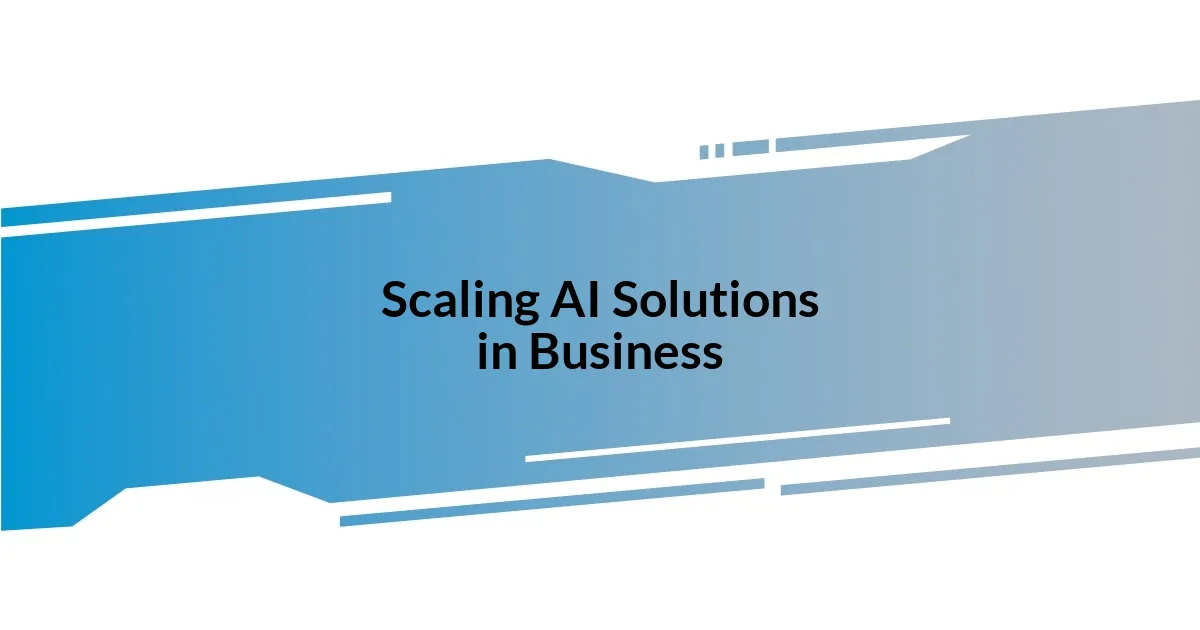
Scaling AI Solutions in Business
Scaling AI solutions in my business was a thrilling challenge that required both strategic foresight and flexibility. I remember when we first expanded our AI customer support tool to include multiple languages. The excitement among the team was palpable, as we plotted out a launch that would not only enhance our service but also reach a wider audience. I truly felt like we were on the brink of unlocking a whole new market!
One of the key takeaways for me was the importance of incremental scaling. I began by piloting AI features with a small subgroup of users before rolling them out company-wide. This approach allowed us to gather feedback and refine our processes. It was gratifying to witness firsthand how minor tweaks based on user input could lead to significant leaps in overall satisfaction. Isn’t it amazing how small adjustments can catalyze bigger changes?
As our AI capabilities grew, I made it a priority to maintain open lines of communication with my team. I often asked, “What’s one feature you think would make a tangible difference for our customers?” These discussions ignited creativity and innovation among us. The moment I saw a colleague’s eyes light up while discussing a potential solution is etched in my memory. It reinforced my belief that scaling AI isn’t merely about technology; it’s about nurturing an environment where ideas can flourish and where everyone feels like they play a part in our journey.